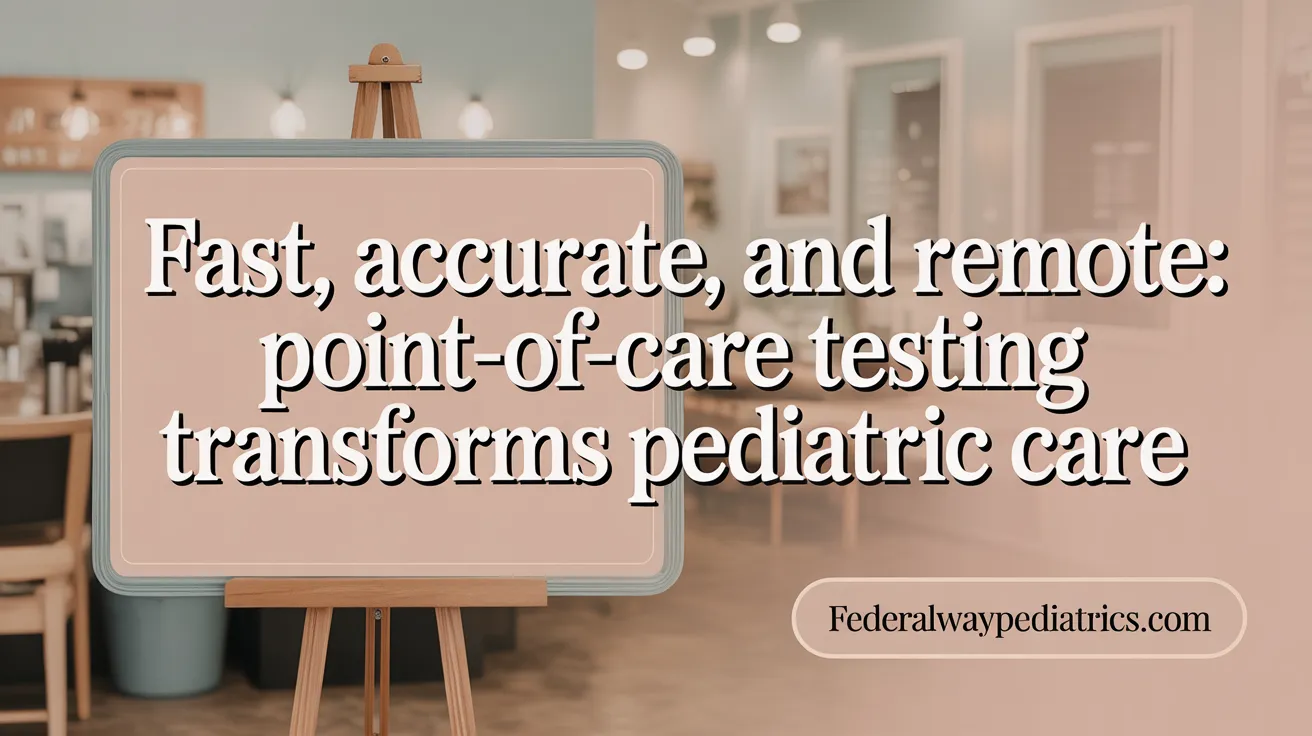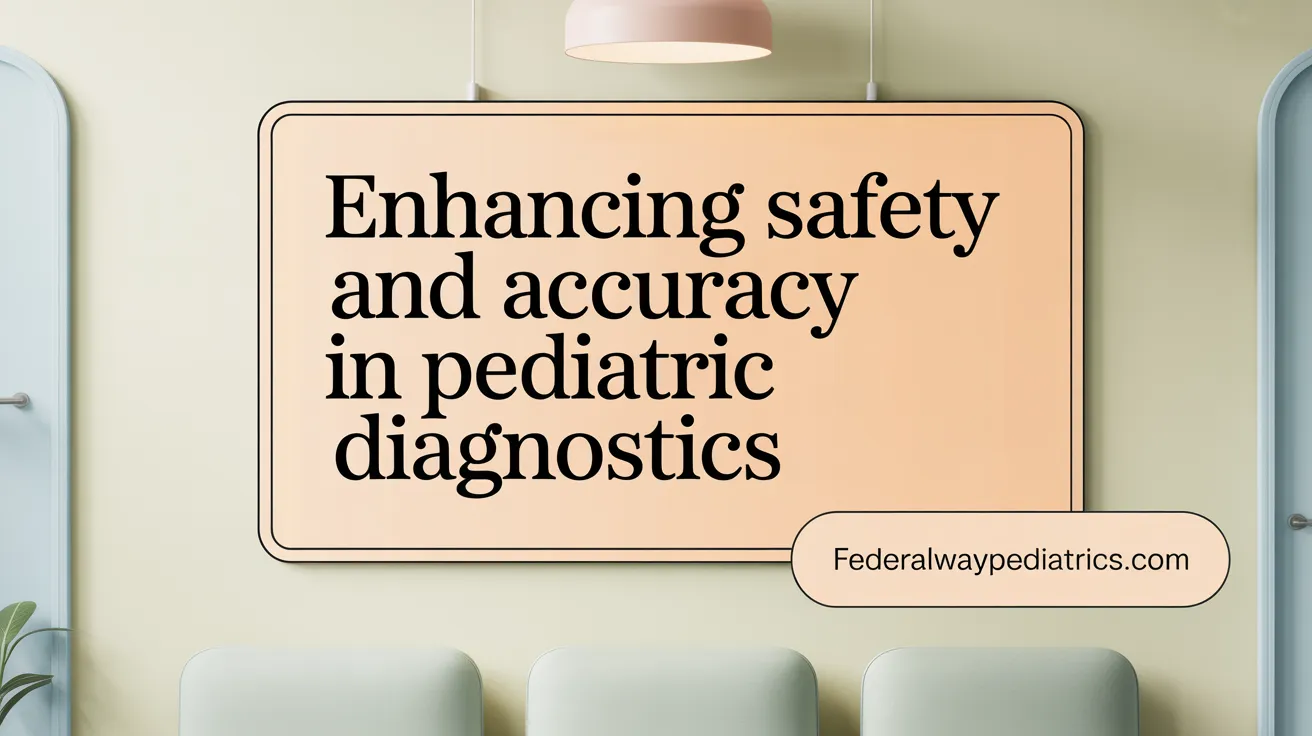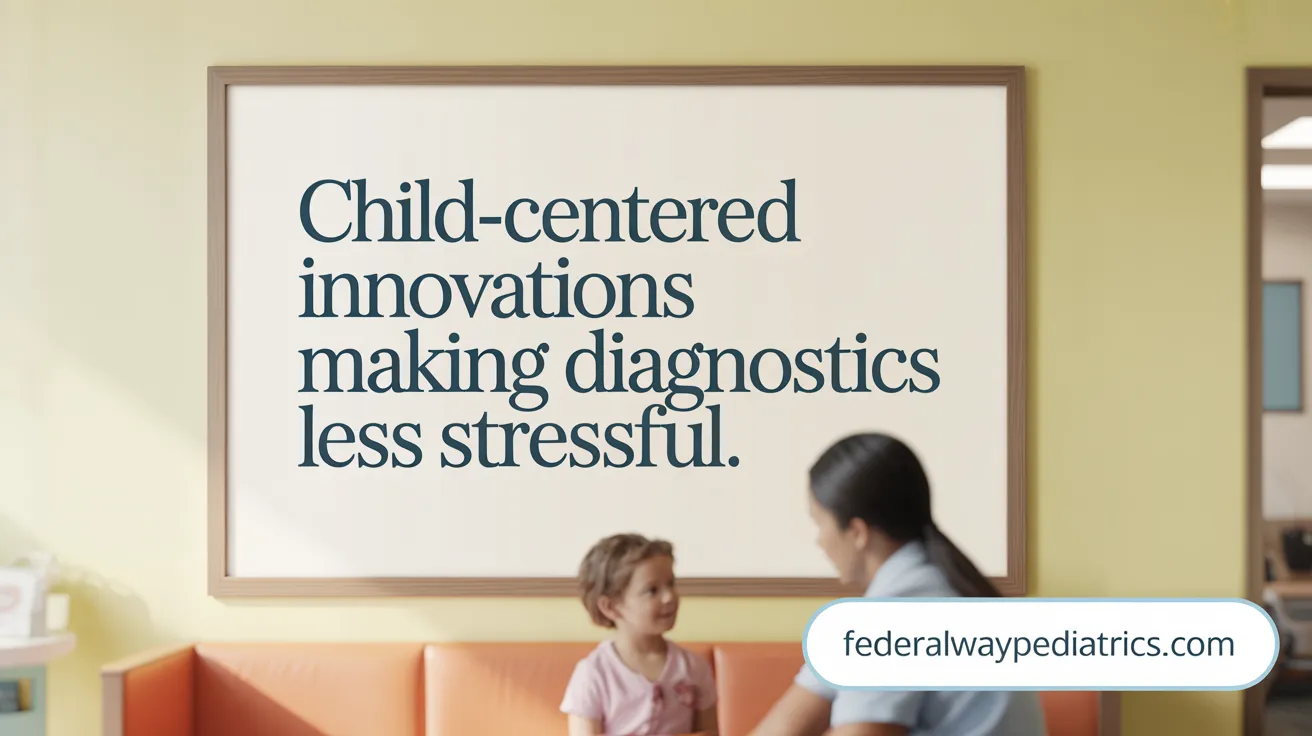Navigating the New Era of Pediatric Diagnostics
Recent years have witnessed groundbreaking progress in pediatric diagnostic services, significantly enhancing the early detection, accuracy, and management of childhood diseases. These advances leverage cutting-edge technologies such as artificial intelligence, genetic sequencing, and innovative imaging techniques tailored specifically for children. This article explores the multifaceted innovations shaping pediatric diagnostics, emphasizing their impacts on clinical outcomes, patient experience, and healthcare delivery.
Precision Medicine and Genetic Testing Revolutionize Pediatric Diagnosis
How is precision medicine advancing pediatric diagnostics?
Precision medicine is transforming pediatric diagnostics through the use of cutting-edge genetic testing technologies like next-generation sequencing (NGS) and whole-genome sequencing (WGS). These tools allow for precise identification of rare genetic disorders in children, something that traditional diagnostic methods often struggle with.
This approach is especially impactful in pediatric oncology, cystic fibrosis, and metabolic disorders. Clinicians can tailor treatment plans based on a child’s specific genetic profile, leading to more effective therapies with fewer side effects. For example, in pediatric cancer care, treatments can be customized to target the genetic mutations driving the disease.
Beyond diagnosis, integrating genetic data supports predictions about disease progression and possible complications. This enables healthcare providers to intervene early and adapt care plans to each child’s unique needs, promoting better outcomes.
The advancement of precision medicine in pediatrics underscores a move toward personalized healthcare, where diagnostic accuracy and individualized treatment planning work hand in hand to improve children’s health and quality of life.
Advanced Imaging Technologies Enhance Diagnostic Safety and Detail

What recent imaging innovations have improved pediatric diagnostics?
Recent advancements in pediatric imaging have notably enhanced both the safety and diagnostic detail available for children.
Specialized radiofrequency coils have been developed specifically for infants and children undergoing MRI scans. These coils improve image resolution while increasing patient comfort, facilitating clearer and more precise imaging (Innovations in pediatric MRI).
Silent MRI protocols, combined with noise-canceling hardware and redesigned gradient coils, reduce the acoustic discomfort traditionally experienced during scans. This advancement enables infants to remain calm or asleep during procedures, significantly decreasing the need for sedation (Innovations in pediatric MRI.
Motion artifact reduction technologies such as real-time motion correction, self-navigated imaging, and optical tracking address the challenge of movement during scans. This results in clearer images and more reliable diagnoses (Innovative pediatric MRI techniques.
Low-dose CT scan protocols have been introduced to balance the need for high-quality imaging with the imperative to minimize radiation exposure. These adjustments allow clinicians to obtain essential diagnostic information while protecting children from unnecessary radiation (Innovative pediatric diagnostics).
Ultrasound technology has advanced with contrast-enhanced imaging, improving visualization of vascular and tissue structures without radiation risks (Precision medicine in pediatrics.
Functional MRI (fMRI) techniques provide insights into brain function and neurological conditions, complementing structural imaging with information about activity patterns (Innovation in Pediatric Healthcare.
Optical coherence tomography (OCT), originally utilized for near-microscopic cross-sectional GI tract imaging, is increasingly applied in pediatric diagnostics for conditions like celiac disease and Crohn’s disease (Advances in Pediatric Diagnostic Endoscopy).
Together, these innovations enhance diagnostic accuracy and safety in pediatric care, offering clearer views of anatomy and function while prioritizing patient comfort and minimizing risks.
Revolutionizing Pediatric Gastrointestinal Diagnosis with Endoscopy Technologies
How have pediatric endoscopy techniques evolved?
Pediatric endoscopy has made significant strides with several innovative techniques enhancing the accuracy and safety of gastrointestinal diagnostics in children.
Chromoendoscopy involves the application of topical dyes such as Lugol’s iodine and methylene blue that highlight mucosal patterns. This improves visualization during endoscopy to detect early changes linked with conditions like Barrett’s esophagus and dysplasia.
Additionally, image-enhanced endoscopy technologies such as narrow-band imaging (NBI), FICE, and i-Scan utilize advanced optics and color filters to better distinguish vascular and mucosal abnormalities. These help identify diseases including gastroesophageal reflux, gastric neoplasia, and inflammatory bowel disease more effectively than standard white-light endoscopy.
Confocal laser endomicroscopy (CLE) provides ultra-high magnification imaging at the cellular level, allowing for real-time, in vivo optical biopsies. This non-invasive approach reduces the need for random biopsies and aids in diagnosing a spectrum of gastrointestinal conditions such as Helicobacter pylori infection, celiac disease, GERD, and eosinophilic esophagitis.
Optical coherence tomography (OCT) complements CLE by offering cross-sectional microscopic imaging of gastrointestinal wall layers. OCT assists in differentiating benign from malignant lesions and characterizing diseases like Crohn’s and celiac disease with promising pediatric applications.
Emerging technologies include wireless motility and pH capsules, which allow non-invasive and radiation-free assessment of gastric emptying and intestinal transit times. Their use is increasing in children for evaluating motility disorders.
Wireless colon capsule endoscopy provides a minimally invasive option to visualize the colon, particularly useful when traditional colonoscopy is incomplete or contraindicated. Early pediatric studies demonstrate high sensitivity and specificity for detecting intestinal inflammation.
Lastly, endoscopic ultrasound (EUS) merges endoscopy with ultrasound imaging, enabling detailed evaluation of pancreatobiliary structures, gastrointestinal wall layers, and extraluminal lesions. In pediatrics, EUS is invaluable for diagnosing pancreatic masses, biliary stones, congenital anomalies, and guiding fine needle aspirations, with emerging therapeutic roles.
Together, these advances in pediatric endoscopy vastly improve early detection, diagnostic precision, and minimally invasive management of gastrointestinal diseases in children, marking a revolution in pediatric gastroenterology.
Artificial Intelligence Accelerates and Enhances Pediatric Diagnostic Accuracy
AI tools for early autism diagnosis
Artificial intelligence is revolutionizing pediatric diagnostics by significantly accelerating the identification of developmental conditions such as autism. Tools like Canvas Dx for autism diagnosis combine parent-reported information, clinical assessments, and video analysis to diagnose or rule out autism within days instead of months. This rapid evaluation aids children in accessing early intervention programs sooner, which is vital for improved developmental outcomes. Other AI-based technologies similarly utilize behavioral data and eye-tracking algorithms to support early screening (AI-assisted early autism screening).
Machine learning in imaging and pattern recognition
Machine learning algorithms play a pivotal role in enhancing the diagnostic precision of pediatric imaging. Deep learning techniques improve image reconstruction in modalities like MRI, helping detect subtle abnormalities and reduce the need for sedation by correcting motion artifacts in real time (Innovations in pediatric MRI. AI tools also analyze complex patterns in genetic and brain imaging data, improving early detection of conditions such as autism, brain tumors, and inflammatory diseases (Machine learning in pediatric healthcare, Technology-based diagnosis of neurodevelopmental disorders).
Integration into primary care workflows
AI assists primary care providers by streamlining screening and referral processes. By improving the accuracy and speed of early diagnoses, AI reduces delays in specialist consultations and helps mitigate pediatrician workload. Furthermore, integration of AI-supported self-management tools enables ongoing behavioral health support between therapy sessions, enhancing long-term care and patient engagement (Advancements in pediatrics with AI, Technology in pediatric behavioral health).
Ethical considerations and provider training
The adoption of AI in pediatric diagnostics is guided by stringent ethical frameworks that emphasize patient data privacy, transparency, and safety. Organizations such as the American Medical Association have established policies addressing liability, cybersecurity, and governance to ensure responsible AI use. Additionally, provider education through continuing medical education (CME) programs helps clinicians effectively implement AI tools while preserving clinical judgment (AMA policies on healthcare AI, AI and digital health in pediatric care).
| Aspect | Role of AI | Impact |
|---|---|---|
| Autism diagnosis | Rapid assessment combining clinical and parental input | Reduces wait times, enables early intervention |
| Imaging enhancement | Improves image quality and artifact correction | Better detection, less sedation needed |
| Primary care integration | Streamlines referrals and screening | Faster treatment initiation, reduces clinician burnout |
| Ethical frameworks & training | Ensures safety, privacy, and proper AI application | Builds trust, supports safe adoption |
Point-of-Care Testing and Remote Monitoring Empower Timely Pediatric Care

How do point-of-care testing and telemedicine improve pediatric diagnostic services?
Point-of-care testing (POCT in pediatric emergency) delivers rapid, bedside diagnostic results that are crucial in pediatric emergency and acute care. These portable devices are specifically designed for use in children, ensuring ease of operation and quick assessment of critical biomarkers, pathogens, and blood parameters. This immediacy reduces delays in diagnosis and intervention, speeding up critical clinical decision-making.
Telemedicine complements POCT by broadening access to pediatric specialists, especially in remote or underserved areas. Through virtual consultations, children and their families can receive expert consultations without the need for travel, facilitating continuity of care and timely specialist input (Telemedicine in pediatric care).
Wearable sensors and remote monitoring technologies support continuous health tracking in children with chronic conditions such as asthma, diabetes, and congenital heart disease. These devices provide real-time data that enable caregivers and clinicians to anticipate health issues earlier and adjust treatment plans promptly (Precision medicine in pediatrics.
Rapid bedside diagnostics in emergency and acute care
- Portable POCT devices enable quick measurement of glucose, electrolytes, and infectious agents at the bedside.
- These technologies reduce emergency department length of stay and improve diagnostic accuracy (Point-of-care testing in pediatric emergency.
Portable devices tailored for children
- Child-friendly design increases acceptance and cooperation.
- Devices are easy to handle with minimal discomfort (Innovative pediatric diagnostics.
Telemedicine and remote consultations
- Virtual care platforms facilitate specialist access without geographic constraints.
- Support ongoing health management and follow-up (Telemedicine in pediatric care.
Wearables and continuous health monitoring
- Sensors track vital signs and disease-specific markers continuously.
- Data-driven care allows proactive interventions, reducing complications (Improving child health with Big Data).
Together, POCT, telemedicine, and wearable technologies create a dynamic network that strengthens pediatric diagnostic services, enhances patient outcomes, and supports families in managing children's health efficiently and effectively.
Big Data and Integrated Analytics Drive Personalized Pediatric Healthcare

What role does Big Data play in advancing pediatric diagnostics?
Big Data plays a transformative role in pediatric diagnostics by integrating vast and diverse sources of health information. This includes electronic health records (EHRs), advanced imaging results, genetic data, and continuous monitoring from wearable devices. By combining these complex datasets, healthcare providers can improve diagnostic accuracy and tailor treatments specifically to each child's needs (Improving child health with Big Data.
How are predictive modeling and risk stratification used in pediatrics?
Predictive models analyze integrated data to identify patterns indicating disease risk early on. These models enable risk stratification, helping clinicians anticipate potential health issues before symptoms arise. As a result, care can be proactive rather than reactive, with interventions targeting those children at highest risk of complications (Improving child health with Big Data.
How does Big Data help reduce disparities and support clinical decisions?
By analyzing large, diverse pediatric populations, Big Data initiatives highlight racial, ethnic, and socioeconomic disparities in healthcare delivery. Understanding these gaps informs targeted strategies to improve equity. Moreover, data-driven decision support tools assist clinicians in making faster, evidence-based diagnoses and treatments, enhancing overall care quality and efficiency (Improving child health with Big Data.
What challenges does Big Data face regarding privacy and collaboration?
Despite its benefits, Big Data use in pediatrics must overcome significant challenges. Protecting patient privacy across multiple institutions requires stringent data security measures and ethical safeguards. Additionally, legal and technical barriers complicate data sharing among healthcare systems, demanding standardized protocols and trust-building efforts. Addressing these issues is critical to fully harnessing Big Data’s potential for advancing child health (Improving child health with Big Data.
Innovative Pediatric Medical Devices and Minimally Invasive Monitoring
What new medical devices are shaping pediatric diagnostics and monitoring?
Innovations in pediatric medical devices are transforming diagnostics and patient care by emphasizing non-invasiveness and portability. Notably, non-invasive sensors developed for cardiovascular pressure monitoring, such as those tracking central venous pressure (CVP) in children with congenital heart disease, provide crucial insights while reducing risks associated with invasive methods (Children’s National Hospital collaboration with Compremium AG).
Smart, portable infant ventilators represent another leap forward, allowing responsive and tailored respiratory support for infants with distress, improving outcomes and comfort (Advances in Pediatric Diagnostics 2023).
Collaboration between leading children's hospitals and tech firms propels these advancements. For example, partnerships like that between Children’s National Hospital and the Swiss company Compremium AG combine clinical expertise with cutting-edge technology to accelerate development and commercialization. These alliances help navigate complex FDA regulatory pathways to ensure devices are not only innovative but also safe and effective for pediatric use (Advancements in pediatric medical device technology).
Such developments enrich pediatric care by offering more precise monitoring and treatment options tailored specifically for children's unique physiological needs, reducing hospital stays and improving overall patient experience (Innovation in Pediatric Healthcare).
Addressing Pediatric Diagnostic Safety and Reducing Errors

How is pediatric diagnostic safety being improved?
Pediatric diagnostic safety is an area of growing focus due to the incidence of missed opportunities for improving diagnosis (MOIDs). Research indicates that around 6.3% of children readmitted within 15 days following discharge experience diagnostic errors. These errors often stem from challenges in clinician decision-making, such as delays in considering correct diagnoses or failure to order necessary tests (Diagnostic errors in pediatric hospital medicine, AHRQ research on pediatric diagnostic safety).
To mitigate these errors, strategies emphasize enhancing clinician judgement through targeted training and education. Quality improvement initiatives, such as pediatric quality improvement collaboratives, foster data sharing, consensus building, and standardized protocols to improve diagnostic accuracy. These collaboratives also encourage family involvement and utilize frameworks like the Breakthrough Series Collaborative Model to accelerate improvements.
Technological solutions are integral to improving safety. Electronic health records (EHRs) are leveraged to support clinical decision-making by providing timely access to comprehensive patient data (Pediatric Diagnostic Safety. Enhanced testing protocols and diagnostic guidelines incorporated into EHRs help reduce diagnostic errors.
Training healthcare providers ensures they are proficient in the latest diagnostic practices and aware of safety protocols. National guidelines and resources from institutions such as the Agency for Healthcare Research and Quality (AHRQ) reinforce the importance of accuracy and safety in pediatric diagnostics (Improving accuracy in pediatric diagnosis.
Collectively, these efforts aim to reduce diagnostic errors, promote early and accurate diagnosis, and ultimately improve health outcomes for pediatric patients.
Advancing Early Autism Screening and Diagnostic Technologies
What are the latest advancements in early autism diagnosis?
Recent innovations in autism diagnosis utilize artificial intelligence (AI) and advanced eye-tracking technologies to enhance early detection. AI-powered tools such as Canvas Dx integrate parent-reported information, clinical assessments, and video data to distinguish autism spectrum disorder (ASD) from other developmental delays rapidly. Similarly, tablet-based devices like EarliPoint employ high-frequency eye-tracking—capturing gaze and social attention patterns—to identify signs of autism in children aged 3 to 7 within about 20 minutes, a dramatic reduction from traditional lengthy evaluations.
AI-assisted behavioral and eye-tracking tools
These AI-driven systems apply deep learning algorithms to analyze behavioral data and visual attention, enabling objective and accurate screening even before conventional symptoms fully emerge. Eye-tracking technology precisely measures gaze responses to social stimuli, highlighting atypical patterns associated with ASD. Mobile applications equipped with neural networks facilitate automated screening beyond clinical settings, broadening reach (Top Mobile Applications in Pediatrics).
Tablet-based diagnostic devices with rapid assessment
Devices like EarliPoint and emerging tools such as Autism Eyes streamline the diagnostic process by providing portable, user-friendly platforms that reduce wait times from months to days. Their rapid assessments support early clinical decision-making and enable quicker access to tailored intervention services.
Benefits of early diagnosis for intervention
Early and accurate identification of autism is pivotal for timely intervention, which has been shown to significantly improve developmental trajectories in social communication and behavior. Early therapies, informed by precise diagnosis, facilitate better long-term outcomes and support family engagement (early autism assessment benefits).
Challenges in accessibility and deployment
Despite promising advances, challenges remain in ensuring widespread, equitable access to these technologies, especially in rural or resource-limited areas. Ongoing efforts focus on rigorous validation, regulatory approvals, and integration into diverse healthcare workflows. Additionally, cost and implementation barriers must be addressed to maximize the global impact of these innovations (Advancements in pediatrics with AI.
Enhancing Diagnostic Experience with Child-Friendly Innovations

How do child-friendly innovations improve pediatric diagnostic experiences?
Child-centric designs in medical devices play a pivotal role in enhancing pediatric diagnostics by reducing fear and promoting cooperation. Devices tailored in size and appearance to be less intimidating help children feel more at ease during examinations and procedures (Innovative Pediatric Diagnostics: Customized Solutions for Young Patients.
Digital platforms that utilize gamified educational tools engage children actively in their health journey. These apps transform complex medical information into interactive, enjoyable experiences, boosting understanding and easing anxieties related to diagnostics (Clinical Tools for Pediatric Care, Top Mobile Applications in Pediatrics.
Psychosocial interventions, including art and music therapy, support emotional well-being during clinical encounters. These therapies create calming environments that help children express emotions and manage stress, resulting in better cooperation with healthcare providers (Innovative Pediatric Diagnostics: Customized Solutions for Young Patients.
Together, these innovations form a comprehensive strategy that makes pediatric diagnostic processes less distressing and more efficient. By addressing emotional and cognitive needs, they improve the overall quality of care and outcomes for young patients (Improving Pediatric Health and Care Quality Measures).
The Future of Pediatric Diagnostics: Toward Precision, Access, and Compassion
Advances in pediatric diagnostic services are revolutionizing healthcare for children by offering unprecedented accuracy, speed, and personalized approaches. Integration of genetic insights, sophisticated imaging, AI-driven tools, and minimally invasive devices empowers clinicians to diagnose and treat childhood diseases more effectively. Furthermore, patient-centered innovations and telemedicine expand access and improve the diagnostic experience for young patients and their families. Continued collaboration among researchers, healthcare providers, and technology developers, alongside thoughtful attention to ethical considerations and equitable access, will ensure these advances translate into better health outcomes for all children worldwide. The future holds promise for diagnostics that are not only more precise but also more compassionate, paving the way for a healthier generation.
